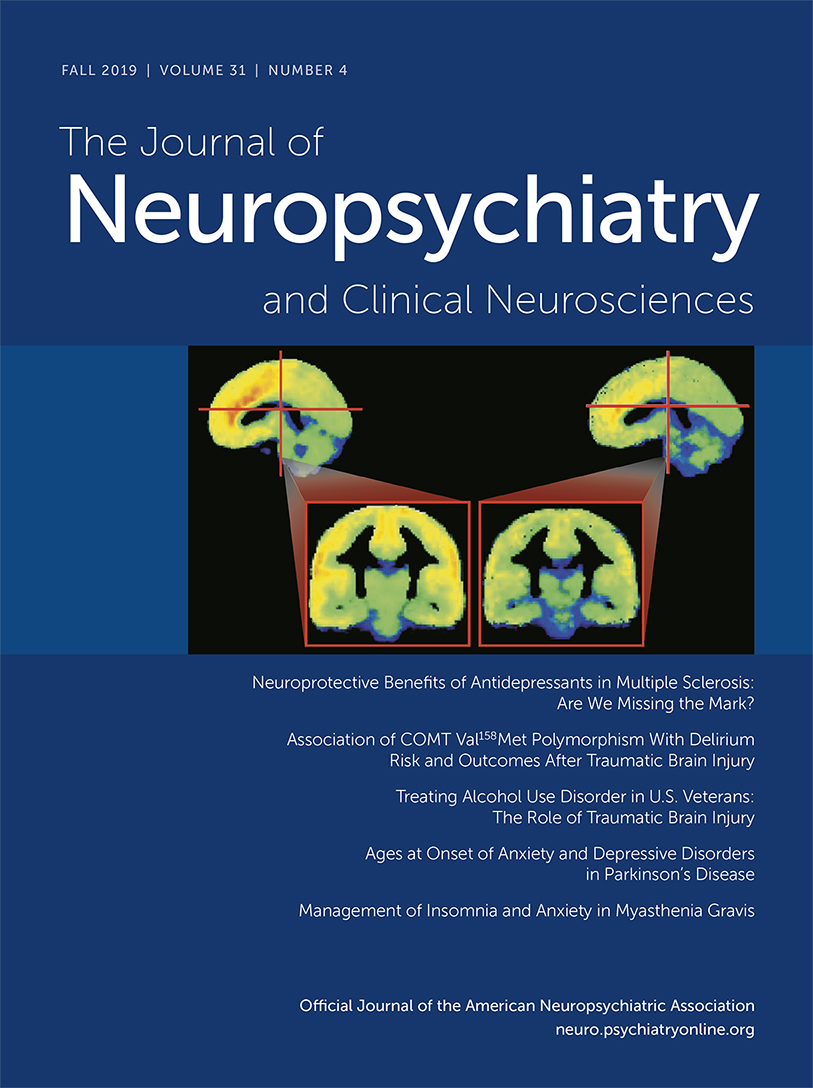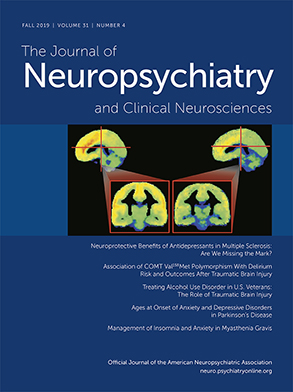Anger and Depression in Middle-Aged Men: Implications for a Clinical Diagnosis of Chronic Traumatic Encephalopathy
Abstract
Objective:
Methods:
Results:
Conclusions:
Methods
Participants
Measures
NIH Toolbox Anger-Affect Fixed Form (version 2.0).
NIH Toolbox Anger-Hostility Fixed Form (version 2.0).
NIH Toolbox Perceived Hostility Fixed Form (version 2.0).
NIH Toolbox Anger-Physical Aggression Fixed Form (version 2.0).
NIH Toolbox Fear-Affect Fixed Form (version 2.0).
Patient-Reported Outcomes Measurement Information System (PROMIS) Depression Short-Form 8b (version 1.0).
Statistical Analyses
Results
| Endorsement (%)a | ||||||||||||
|---|---|---|---|---|---|---|---|---|---|---|---|---|
| Extremely untrue of me | Extremely true of me | |||||||||||
| Item | Mean | Median | SD | 1 | 2 | 3 | 4 | 5 | 6 | 7 | 5–7 | 6–7 |
| Physical aggression | ||||||||||||
| If I am provoked enough, I may hit another person. | 2.05 | 1 | 1.62 | 59.6 | 14.5 | 6.0 | 8.4 | 6.0 | 3.0 | 2.4 | 11.4 | 5.4 |
| I get into fights a little more than the average person. | 1.28 | 1 | 0.82 | 84.2 | 9.1 | 4.2 | 1.2 | 0.0 | 0.6 | 0.6 | 1.2 | 1.2 |
| There are people who pushed me so far that we came to blows. | 1.64 | 1 | 1.35 | 71.7 | 14.5 | 4.2 | 3.0 | 3.0 | 1.2 | 2.4 | 6.6 | 3.6 |
| I have threatened people I know. | 1.42 | 1 | 1.05 | 80.6 | 7.3 | 6.7 | 2.4 | 1.8 | 0.0 | 1.2 | 3.0 | 1.2 |
| I have become so mad that I have broken things. | 1.59 | 1 | 1.24 | 71.1 | 15.7 | 6.6 | 1.8 | 1.2 | 1.8 | 1.8 | 4.8 | 3.6 |
| Hostility | ||||||||||||
| I am sometimes eaten up with jealousy. | 1.81 | 1 | 1.27 | 56.6 | 24.7 | 9.0 | 4.2 | 3.0 | 0.6 | 1.8 | 5.4 | 2.4 |
| At times I feel that I have gotten a raw deal out of life. | 2.39 | 2 | 1.60 | 39.4 | 26.7 | 10.9 | 9.1 | 7.9 | 4.2 | 1.8 | 13.9 | 6.0 |
| Other people always seem to get the breaks. | 2.46 | 2 | 1.60 | 36.1 | 25.9 | 15.7 | 9.0 | 6.6 | 4.2 | 2.4 | 13.2 | 6.6 |
| I wonder why sometimes I feel so bitter about things. | 2.29 | 2 | 1.58 | 45.2 | 21.1 | 12.7 | 9.6 | 4.8 | 5.4 | 1.2 | 11.4 | 6.6 |
| I sometimes feel that people are laughing at me behind my back. | 1.93 | 1 | 1.50 | 59.0 | 18.7 | 7.8 | 6.0 | 4.2 | 1.2 | 3.0 | 8.4 | 4.2 |
| Never | Rarely | Sometimes | Often or usually | Always | Often or always | |||||||||||
|---|---|---|---|---|---|---|---|---|---|---|---|---|---|---|---|---|
| Item | N | Mean | Median | SD | N | % | N | % | N | % | N | % | N | % | N | % |
| Anger (past 7 days) | ||||||||||||||||
| I was irritated more than people knew. | 166 | 1.97 | 2 | 0.88 | 61 | 36.7 | 55 | 33.1 | 44 | 26.5 | 6 | 3.6 | 0 | 0 | 6 | 3.6 |
| I felt angry. | 166 | 1.95 | 2 | 0.87 | 59 | 35.5 | 64 | 38.6 | 35 | 21.1 | 8 | 4.8 | 0 | 0 | 8 | 4.8 |
| I felt like I was ready to explode. | 166 | 1.60 | 1 | 0.81 | 98 | 59.0 | 40 | 24.1 | 25 | 15.1 | 3 | 1.8 | 0 | 0 | 3 | 1.8 |
| I was grouchy. | 166 | 2.14 | 2 | 0.86 | 42 | 25.3 | 67 | 40.4 | 50 | 30.1 | 6 | 3.6 | 1 | 0.6 | 7 | 4.2 |
| I felt annoyed. | 166 | 2.09 | 2 | 0.89 | 50 | 30.1 | 59 | 35.5 | 49 | 29.5 | 8 | 4.8 | 0 | 0 | 8 | 4.8 |
| Perceived hostility (past month)a | ||||||||||||||||
| Argue with me. | 163 | 2.16 | 2 | 0.90 | 45 | 27.6 | 55 | 33.7 | 57 | 35.0 | 4 | 2.5 | 2 | 1.2 | 6 | 3.7 |
| Act in an angry way toward me. | 163 | 1.90 | 2 | 0.81 | 58 | 35.6 | 67 | 41.1 | 34 | 20.9 | 4 | 2.5 | 0 | 0 | 4 | 2.5 |
| Criticize the way I do things. | 163 | 2.31 | 2 | 0.81 | 26 | 16.0 | 70 | 42.9 | 59 | 36.2 | 7 | 4.3 | 1 | 0.60 | 8 | 4.9 |
| Yell at me. | 163 | 1.69 | 1 | 0.86 | 85 | 52.1 | 49 | 30.1 | 25 | 15.3 | 2 | 1.2 | 2 | 1.2 | 4 | 2.4 |
| Get mad at me. | 163 | 2.15 | 2 | 0.82 | 35 | 21.5 | 75 | 46.0 | 48 | 29.4 | 3 | 1.8 | 2 | 1.2 | 5 | 3.0 |
| Blame me when things go wrong. | 163 | 2.05 | 2 | 0.86 | 47 | 28.8 | 69 | 42.3 | 40 | 24.5 | 6 | 3.7 | 1 | 0.6 | 7 | 4.3 |
| Act nasty toward me. | 163 | 1.75 | 2 | 0.84 | 78 | 47.9 | 51 | 31.3 | 30 | 18.4 | 4 | 2.5 | 0 | 0 | 4 | 2.5 |
| Tease me in a mean way. | 163 | 1.44 | 1 | 0.67 | 107 | 65.6 | 42 | 25.8 | 13 | 8.0 | 1 | 0.6 | 0 | 0 | 1 | 0.6 |
| Anxiety (past 7 days) | ||||||||||||||||
| I felt fearful. | 166 | 1.56 | 1 | 0.80 | 101 | 60.8 | 41 | 24.7 | 20 | 12.0 | 4 | 2.4 | 0 | 0 | 4 | 2.4 |
| I felt anxious. | 166 | 2.04 | 2 | 0.91 | 56 | 33.7 | 56 | 33.7 | 45 | 27.1 | 9 | 5.4 | 0 | 0 | 9 | 5.4 |
| I felt worried. | 166 | 2.23 | 2 | 0.96 | 45 | 27.1 | 53 | 31.9 | 55 | 33.1 | 11 | 6.6 | 2 | 1.2 | 13 | 7.8 |
| I found it hard to focus on anything other than my anxiety. | 166 | 1.73 | 1 | 0.88 | 86 | 51.8 | 46 | 27.7 | 27 | 16.3 | 7 | 4.2 | 0 | 0 | 7 | 4.2 |
| I felt nervous. | 166 | 2.01 | 2 | 0.92 | 57 | 34.3 | 61 | 36.7 | 41 | 24.7 | 4 | 2.4 | 3 | 1.8 | 7 | 4.2 |
| I felt uneasy. | 166 | 2.02 | 2 | 0.88 | 53 | 31.9 | 65 | 39.2 | 42 | 25.3 | 4 | 2.4 | 2 | 1.2 | 6 | 3.6 |
| I felt tense. | 166 | 2.25 | 2 | 0.91 | 41 | 24.7 | 55 | 33.1 | 58 | 34.9 | 12 | 7.2 | 0 | 0 | 12 | 7.2 |
| Depression (past 7 days) | ||||||||||||||||
| I felt worthless. | 166 | 1.49 | 1 | 0.80 | 110 | 66.3 | 35 | 21.1 | 18 | 10.8 | 1 | 0.6 | 2 | 1.2 | 3 | 1.8 |
| I felt that I had nothing to look forward to. | 166 | 1.53 | 1 | 0.81 | 107 | 64.5 | 34 | 20.5 | 22 | 13.3 | 2 | 1.2 | 1 | 0.6 | 3 | 1.8 |
| I felt helpless. | 166 | 1.60 | 1 | 0.82 | 98 | 59.0 | 40 | 24.1 | 24 | 14.5 | 4 | 2.4 | 0 | 0 | 4 | 2.4 |
| I felt sad. | 166 | 2.06 | 2 | 0.89 | 53 | 31.9 | 58 | 34.9 | 47 | 28.3 | 8 | 4.8 | 0 | 0 | 8 | 4.8 |
| I felt like a failure. | 166 | 1.62 | 1 | 0.84 | 98 | 59.0 | 36 | 21.7 | 30 | 18.1 | 1 | 0.6 | 1 | 0.6 | 2 | 1.2 |
| I felt depressed. | 166 | 1.92 | 2 | 0.92 | 70 | 42.2 | 47 | 28.3 | 43 | 25.9 | 5 | 3.0 | 1 | 0.6 | 6 | 3.6 |
| I felt unhappy. | 166 | 2.07 | 2 | 0.90 | 51 | 30.7 | 62 | 37.3 | 45 | 27.1 | 7 | 4.2 | 1 | 0.6 | 8 | 4.8 |
| I felt hopeless. | 166 | 1.61 | 1 | 0.88 | 99 | 59.6 | 39 | 23.5 | 23 | 13.9 | 3 | 1.8 | 2 | 1.2 | 5 | 3.0 |
| Spearman correlation | |||||
|---|---|---|---|---|---|
| Item | Anger | Physical aggression | Hostility | Perceived hostility | Anxiety |
| Physical aggression | 0.28* | – | |||
| Hostility | 0.44* | 0.37* | – | ||
| Perceived hostility | 0.35* | 0.29* | 0.31* | – | |
| Anxiety | 0.61* | 0.28* | 0.51* | 0.40* | – |
| Depression | 0.51* | 0.27* | 0.56* | 0.35* | 0.78* |
| No depression | Possible depression | ||||||||
|---|---|---|---|---|---|---|---|---|---|
| Item | N | Mean | SD | N | Mean | SD | t | p | Cohen’s d |
| Anger | 117 | 8.81 | 2.92 | 49 | 11.98 | 3.64 | –3.17 | <0.001 | 0.96 |
| Physical aggression | 116 | 7.28 | 3.79 | 49 | 9.61 | 5.72 | –2.34 | 0.01 | 0.48 |
| Hostility | 116 | 9.39 | 4.90 | 49 | 14.63 | 6.12 | –5.34 | <0.001 | 0.95 |
| Perceived hostility | 115 | 14.80 | 4.52 | 48 | 17.02 | 5.77 | –2.22 | 0.02 | 0.43 |
| Anxiety | 117 | 12.01 | 3.86 | 49 | 18.16 | 4.30 | –6.15 | <0.001 | 1.51 |
| “I felt hopeless” | 117 | 1.26 | 0.53 | 49 | 2.45 | 0.98 | –10.03 | <0.001 | 1.51 |
Discussion
Depression
Anger Control Problems
Limitations
Conclusions
Footnote
References
Information & Authors
Information
Published In
History
Keywords
Authors
Funding Information
Metrics & Citations
Metrics
Citations
Export Citations
If you have the appropriate software installed, you can download article citation data to the citation manager of your choice. Simply select your manager software from the list below and click Download.
For more information or tips please see 'Downloading to a citation manager' in the Help menu.

